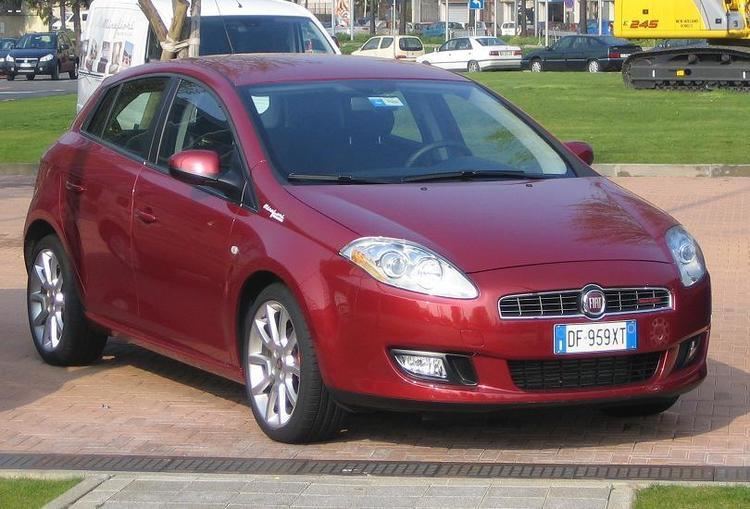Manufacturer Fiat Designer Centro Stile Fiat | Also called Fiat Ritmo (Australia) Class Small family car (C) | |
 | ||
Production 2007–2014 (Italy)2010–2016 (Brazil) Assembly Italy: Cassino, FrosinoneBrazil: Betim, Minas Gerais (Fiat Automóveis) | ||
The Fiat Bravo (Type 198) is a small family car produced by Italian manufacturer Fiat since 2007. It was introduced to the press in January 2007 in Rome, and later to the public in March at the Geneva Motor Show.
Contents
A minor facelift was available since 2010, with changes to the front grille, door handles and side mirrors, new colors, as well as interior improvements.
European production at the Cassino plant ended in July 2014, being part of FCA's 5–Year Plan, presented by Sergio Marchionne on May 7, 2014. While no direct replacement was launched, the similarly sized Fiat 500X occupies the position previously held by the Bravo in Fiat's current line-up.
The Bravo was the first car to bear Fiat Automobiles' current logo, introduced in October 2006, which contains a red background in a chrome frame.
History
The car was designed at Centro Stile Fiat, while Austrian automotive company Magna Steyr engineered a large amount of the car's body. CAD engineering and computer simulations were used on a very large scale with this model and the design was finished to a very tight schedule. For EMEA markets the Bravo was produced in Fiat's Piedimonte S. Germano plant.
Blue&Me is a new feature first introduced with the Fiat Grande Punto and is fitted as standard on the Bravo Dynamic and Sport. Developed with Microsoft, this system offers Bluetooth hands-free use with a mobile phone. It is also capable of displaying SMS text on the dash screen and it has built-in voice activation. Another part of the system is the inclusion of a USB connector so that an MP3 player or USB flashcard can be plugged in, giving the car's entertainment system access to MP3 files stored on the unit.
In Australia, the Fiat Bravo was sold as the Fiat Ritmo since Mazda Australia owns rights to the "Bravo" name (as used on a commercial vehicle). It was introduced there in February 2008, however, it was discontinued the following year, due to slow sales - only 463 units were sold in total. The Bravo is also being built in Brazil since 2010, and is being sold there and throughout South America (with the exception of Argentina, Chile and Colombia, who receive the Bravo from Italy).
In January 2007, What Car? reported that Fiat was working on a station wagon version, speculated to be marketed as the Bravo MultiWagon. Despite being a production-ready version of the Bravo, it was never marketed. Other sources also claimed that this was actually a facelifted of the second generation Fiat Croma, launched in October 2007.
Brazilian version
The Brazilian-built Bravo went on sale in 2010 in Brazil. Its available with two engines and three trim levels (five trim levels since 2012), the Brazilian-built 1.8L 16V E.torQ (based on Tritec engine) fitted with a 5-speed manual transmission or Dualogic transmission and Italian built 1.4L engine with 152 PS (112 kW; 150 hp) (with Overboost option) and a 6-speed manual transmission. Trim levels are named as: Essence (1.8), Essence Wolverine Limited Edition (1.8), Sporting (1.8), Absolute (1.8) and T-Jet (1.4T).
Engines
The Bravo is powered by three different petrol and three diesel engines. 'T-Jet' is the name of the new range of turbocharged petrol engines.
Some models of the 150 PS (110 kW; 148 hp) T-Jet version have a Sport button to give an "overboost" function. At the end of 2007 the new 1.6 L M-jet diesel engine was launched, and a more powerful 120 PS (88 kW; 120 hp) version in spring 2008. The 105 PS (77 kW; 104 hp) version is available with the so-called "Eco" pack which features changes to the car's aerodynamics and ECU, taller gear ratios and lower rolling resistance tyres. This gives better fuel consumption and lower CO2 emissions (119 g/km) when compared to the standard car. This engine is also Euro 5 rated. A new 2.0 Multijet diesel was added to lineup at the end of 2008 that will slowly replace the 1.9 16v. In 2009 the Bravo got a new "eco" 90 PS (66 kW; 89 hp) variant of the Multijet diesel. In the Summer of 2010 two petrol engines were updated, the 1.4 T-Jet is fitted with the new Multiair technology and the base 1.4 T-Jet was also updated to Euro 5 specification.
Safety
The Fiat Bravo passed the Euro NCAP car safety tests with following ratings:
